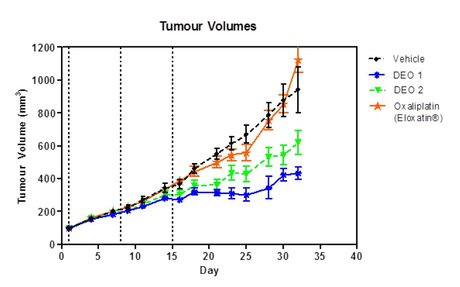Starpharma developing new chemotherapy formulation

Starpharma (ASX:SPL) has successfully applied its dendrimer platform technology to a new high-profile chemotherapy drug.
A dendrimer-enhanced version of chemotherapy drug oxaliplatin (sold as Eloxatin by Sanofi) achieved improved tumour-inhibiting efficacy while reducing overall toxicity in a mouse model of colon cancer.
The dendrimer-oxaliplatin formulation notably significantly reduced neutropenia, a life-threatening toxicity common to oxaliplatin treatments. Bone marrow toxicities including neutropenia occur in an estimated 70% of patients treated with the chemotherapy.
Starpharma CEO Dr Jackie Fairley said the company now intends to advance dendrimer-enhanced oxaliplatin formulations into development. The company is involved in additional studies to explore the positive impact of the formulation on bone marrow toxicity.
“Currently, patient outcomes with oxaliplatin in colon cancer are negatively impacted by [the] toxicities, so the clinical and commercial potential of an improved oxaliplatin product which offers both enhanced efficacy and reduced bone marrow toxicity is very significant,” Fairley said.
Starpharma’s first dendrimer formulation of a chemotherapy drug, dendrimer-docetaxel, is due to enter a phase I trial later this year. Animal trials suggest this formulation could be potentially 40 times more effective at targeting tumours than conventional docetaxel.
Starpharma announced last year that UK pharmaceutical giant AstraZeneca was evaluating oncology molecules from the company’s dendrimer platform.
Starpharma (ASX:SPL) shares were trading 1.5% lower at $0.985 as of around 1 pm on Wednesday.
Mini lung organoids could help test new treatments
Scientists have developed a simple method for automated the manufacturing of lung organoids...
Clogged 'drains' in the brain an early sign of Alzheimer’s
'Drains' in the brain, responsible for clearing toxic waste in the organ, tend to get...
World's oldest known RNA extracted from woolly mammoth
The RNA sequences are understood to be the oldest ever recovered, coming from mammoth tissue...





